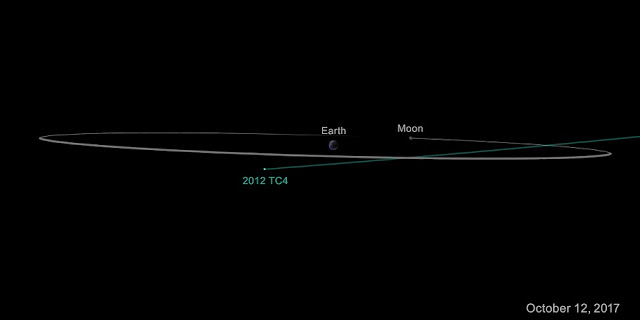The house-sized asteroid 2012 TC4 is slated to give Earth a close shave on Thursday, October 12, swooshing by our planet at approximately 5:41 UTC (1:41 a.m. EDT) at a distance of about 31,000 miles (50,000 kilometers). Although there were some worries that this rocky object could hit the Earth, latest observations confirm that it poses no danger to our home planet at all.
“The actual miss distance is pinned down to around 50,000 kilometers, which makes it about a once in two years occurrence, a bit noteworthy, but not really a very big deal. There is no hazard in its upcoming pass or anytime in the near future,” Alan Harris, a former Jet Propulsion Laboratory (JPL) researcher told Astrowatch.net.
Asteroid 2012 TC4 was discovered on Oct. 4, 2012 by the Pan-STARRS observatory in Hawaii. Week later, it gave Earth a close shave when it passed the planet at the distance of 0.247 LD (lunar distance), or 58,900 miles (94,800 kilometers).
Observations reveal that 2012 TC4 is an elongated and rapidly rotating object and has been known to make many close approaches to Earth in the past. The space rock orbits the sun approximately every 1.67 years at a distance of about 1.4 AU. Astronomers estimate that 2012 TC4 has a diameter between 26 to 85 feet (8 to 26 meters).
Calculations revealed by JPL in July 2017 indicated that 2012 TC4 could pass as close as 4,200 miles (6,800 kilometers). These results were based on only seven days of tracking of this asteroid after it was discovered. However, new observations of this space rock conducted at the European Southern Observatory (ESO) by Olivier Hainaut, Detlef Koschny and Marco Micheli of the European Space Agency (ESA) in July and August 2017, show different estimates.
“The new calculations indicate that TC4 will fly safely past our planet on Oct. 12, at a distance of about 43,500 kilometers (27,000 miles) above the surface, or about one-eighth of the distance to the Moon,” JPL informed.
Therefore, new data provided by the latest observational campaign exclude the possibility of 2012 TC4 hitting our planet. Harris underlines that even if this asteroid crashed into Earth it would not cause any major damage.
“It is small enough (about the size of the Chelyabinsk meteor) that even if it impacted it would be unlikely to cause any major damage. Recall that the Chelyabinsk meteor only caused substantial damage and injuries because it chanced to hit over a populated area. Over most of the Earth’s area, it would have been completely harmless,” Harris said.
The meteor that exploded over the Russian city of Chelyabinsk in February 2013, injuring 1,500 people and damaging over 7,000 buildings, was about 66 feet (20 meters) wide.
The upcoming close approach of 2012 TC4 will offer a great opportunity for astronomers worldwide to observe an asteroid from a relatively close distance. The asteroid’s fly-by will be also monitored by the International Asteroid Warning Network as part of an exercise of the recovery, characterization and reporting of a potentially hazardous object approaching Earth.
“The October pass will bring the asteroid up to magnitude 14, so extensive physical studies will be possible, but only briefly. It probably is a fast rotator (period under an hour) so full rotational coverage likely can be obtained in a single night,” Harris told Astrowatch.net.
Source: Astrowatch.net

































Leave a Comment
You must be logged in to post a comment.